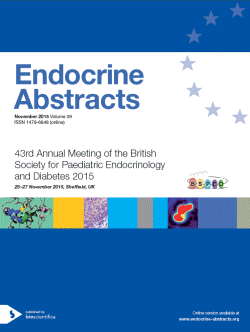Searchable abstracts of presentations at key conferences in endocrinology

Society for Endocrinology BES 2015
Edinburgh,
UK
02 Nov 2015 - 04 Nov 2015

2-4 November 2015, Edinburgh, UK
Further information
ea0038mte1 | (1) | SFEBES2015
Cutting edge imaging of whole endocrine organs
Recent advances in tridimensional (3D) tissue imaging and development of reporter proteins have provided new insight into the dynamic relationship between tissue structure, function and dysfunction in a number of fields of research. In developmental biology 3D microscopy has enabled building of quantitative 3D atlases of embryo morphology and gene expression at cellular resolution and in neuroscience connectomics, the building of 3D brain connectivity maps is a rap...
ea0038mte3 | (1) | SFEBES2015
Optimising fertility in teenage cancer survivors
Recent advances in the treatment of teenage cancers have led to an increasing focus on the late effects of treatment, amongst which fertility is prominent with surveys ranking potential loss of fertility as amongst the most important concerns of teenage and young adult patients. The various treatments for teenage cancer including chemotherapy, radiotherapy and surgery can all potentially compromise fertility with the most toxic therapies being alkylating agent based chemothera...
ea0038mte4 | (1) | SFEBES2015
Investigation and management of TSHoma
Background: Thyrotropinomas (TSHomas) have traditionally been considered a rare, albeit important cause of thyrotoxicosis. However, a recent report suggests their prevalence may be 23 times higher than previously suspected. In addition, although early case series described a predominance of invasive macroadenomas, recent findings (including in our own cohort of 40 patients) confirm that microadenomas are being increasingly diagnosed, and the clinical/biochemical phenotyp...
ea0038mte6 | (1) | SFEBES2015
Frontiers in the management of hypoparathyroidism
Treatment of hypoparathyroidism with vitamin D analogs and calcium does not restore normal physiologic regulation of calcium homeostasis in the bone and kidney and may lead to renal insufficiency due to progressive nephrocalcinosis. Replacement with PTH potentially addresses this problem but until recently, hypoparathyroidism was the only classic hormonal insufficiency state not treated with its missing hormone.Over the past two decades, we have evaluate...
ea0038mte7 | (1) | SFEBES2015
Designer receptors exclusively activated by designer drugs (DREADD) – novel pharmacological handles on the endocrine system
Chemogenetic technologies afford the real-time control of molecularly-defined populations of neurons in a spatially and temporally specific fashion. The ability to remotely activate and silence neurons within the context of genetically-intact freely behaving mice provides unprecedented insight into their physiological function and pathological potential. Used in combination with other genetically-encoded tools this approach facilitates the deconvolution of the neural circuitry...
ea0038mte8 | (1) | SFEBES2015
Meet the Expert 8: updated thyroid cancer guidelines
Previous UK guidelines (2002, 2007) focused on reducing regional variations in practice, concentrating expertise (especially surgical), and eliminating clinical, radiological and biochemical evidence of persistent disease. The 2014 guidelines aim to improve the overall survival while enhancing the health-related quality of life of patients. This presentation will discuss areas of the guidelines that are significantly different from the previous edition of the guidelines and ar...
ea0038mte9 | (1) | SFEBES2015
The term pituitary tumour usually implies an adenoma arising from anterior pituitary tissue, but in fact some 25% of tumours in this region are not adenomas, and many of these arise from the para-sellar region or within the hypothalamus. One clue as to the non-adenomatous origin of such tumours is the presence of diabetes insipidus, which is almost never present with a primary pituitary adenoma. Some 1% of sellar masses are metastases, most often from the fre...
ea0038mte10 | (1) | SFEBES2015
Diagnosis and management of SIADH meet the Expert 10
Hyponatraemia is the commonest electrolyte abnormality in hospitalised patients and every published series has demonstrated that hyponatraemia is associated with increased mortality and substantial morbidity, including longer duration of hospital stay. The debate between the contribution between hyponatraemia and the causative condition to the increased mortality remains to be resolved, but increasing evidence points to an independent association with hyponatraemia. It is not ...



